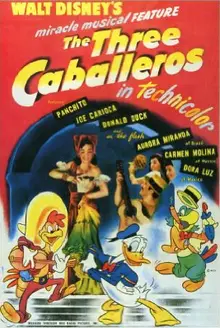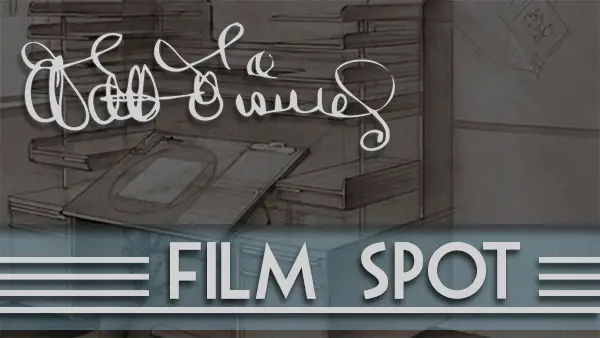Another in a long line of Disney packaged films, The Three Caballeros is a brisk 72-minute romp through the cultures and festivities of Latin America, as seen through the eyes of the artists and animators accompanying Walt Disney on his goodwill tour of the land. Compared to the previous film, Saludos Amigos, The Three Caballeros contains more shorts and features various Latin American stars.
Most famously, The Three Caballeros introduces the team of Donald Duck, Jose Carioca, and their new friend, Panchito the rooster. The eponymous song, featuring animation by Nine Old Men veteran Ward Kimball, is prominent in that it features some of the first surrealistic imagery that broke Disney standards. Rather than adhere to the physics established by previous Disney films and the realism that Walt Disney strove for in his initial works with Snow White and Pinocchio, Ward Kimball desired to take the lyrics for The Three Caballeros literally and subject the characters to an almost Dali-type scenario, breaking continuity and animation principles. When a character ran offscreen right, they reappeared left. Plants would grow and dissipa te at a moment’s notice. The ending itself is a bit of a mystery, an expected surprise, especially since the short came from Ward Kimball, who was known for his iconoclastic artwork (as well as behavior).
te at a moment’s notice. The ending itself is a bit of a mystery, an expected surprise, especially since the short came from Ward Kimball, who was known for his iconoclastic artwork (as well as behavior).
Another endearing short from The Three Caballeros are the Aracuan Bird segments. The Aracuan Bird seems to be another character from this film that has stood the test of time. Once again, the exaggerated cartooniness of the short was a departure from the realism of previous works. The shift away from realism in these packaged films may not have been intentional, but they were a much-needed break from the drama of World War II. While live-action films capitalized on the war with stars like Humphrey Bogart, Disney provided a much-needed escapism and the lighthearted fare of the cartoony packaged films helped to contribute to the easing of the American spirit, especially for the American soldiers.
It is hard to talk about the packaged films in any sort of significant context, they were made during a period in Disney’s history when it was necessary to make them, yet their legacies have not been held up as importantly as previous or later Disney films. World War II seemed to have been a period that the Walt Disney Studios tried their best to survive through, doing the best they could to churn out products despite the difficulties, due to both internal and external problems. Films like The Three Caballeros may not have as lasting an impact as Snow White and the Seven Dwarfs, but they deserve their due credit, considering the circumstances.


